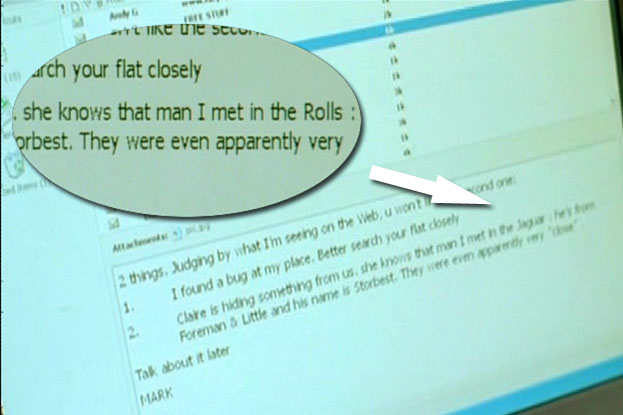|
London. A guy witnesses a live murder on a web cam. Overcome by
panic, he tries to
call the police, but during the call he realizes that he has no
idea who the victim really is, or where she lives, so his call has
been futile. He hangs up without identifying himself. The police
trace those emergency calls, of course, so they show up at his house,
knowing he is either their only witness or the killer.
This idea might have germinated a great movie. This garbled
straight-to-vid effort is not that
movie.
In fact, it is difficult to find anything positive to say about it. The
negatives are easy to spot:
- The cinematography seems to have been done by the same guy
who did the Rob Lowe sex tape. Half of it is dark and
indecipherable. The other half consists of screen grabs of
grainy web cams.
- The storyline is about as coherent as in the film the
stowaways made on Gilligan's Island. The stowaways, however,
did a better job of editing.
- The action scenes are bungled. Characters fall out of
frame; dialogue is garbled; bullets hit body parts in close-up
so that the identity of the victim can't be determined; a
large, violent, armed man has difficulty escaping from an
unarmed Edward Furlong.
- The technology pictured in the film does not exist. The
magic cam, which can follow characters no matter where they
go, is the same imaginary technology George Burns used to
watch Connie Stevens on "Wendy and Me." People watch other
people from a 45 degree overhead angle no matter where they
go. If a character walks along a Paris boulevard, somebody
will be watching him on a web cam just ahead of him and just
above his head, as if he had stayed in his apartment.
Sometimes they even have sound. One must
wonder where, exactly, that camera is positioned. Maybe on a
satellite with a really good zoom lens. That's only one
example of the technological misconceptions. The characters
have dial-up connections, for example, that work about a
thousand times faster than broadband. They connect to
fully-loaded web sites as quickly as you and I can get a new
channel with the TV remote. Wireless web cams are placed just
about everywhere in London, and they all run on
super-batteries with an infinite life.
- The characters have to behave stupidly in service of the
illogical plot. Edward Furlong was in London at the time the woman
was being murdered in Amsterdam. The police can determine he
was on his desktop PC at the time, because they confiscated
his hard drive and can monitor many of his activities during
the previous night, just as they could from your hard drive or
mine. The computer keeps track of when e-mails are sent, when
files are saved or deleted, and so forth. Even streaming video
would leave records in temporary files. Because the police
always accuse the protagonist in plots like this, thus
requiring him to prove his innocence, the police accuse him of
the logistically impossible murder, and want to hold him until
a sympathetic female cyber-detective has "a gut feeling" that
he's innocent. The saddest part is that the coppers really
believe that he did it! This might have made for a compelling
(if clichéd) plot line - IF he hadn't left a trail of evidence
so obvious that any fairly technical eighth grader could
easily have determined that he really was at his desk in
London, just from his hard drive alone.
- The continuity is non-existent.
For example, one e-mail message says,
"She knows that man I met in the Jaguar." When the character
reads it in close-up, it says, "She knows that man I met in
the Rolls."

-
Some of the acting is below the level of a decent summer stock
company. Apparently they could not find an American actor to
play Furlong's brother, so they cast a Londoner who does the
worst American accent since Monty Python's Graham Chapman.
(And Chapman was doing it poorly on purpose, for comic
effect.) The brother sounds like a Bulgarian who learned how
to speak English in a lower-class Dublin neighborhood. I was
wondering how such a thing could have happened in a
professional film until I noticed that the director was
French. Obviously he couldn't hear the problem, any more than
I would know whether a German speaker was really Bavarian or a
man from Saxony mocking a Bavarian accent.
- Because of the editing, technical, scripting, acting, and
continuity errors, the audience is left dumbfounded by the
plot in general, but that level of confusion wasn't quite high
enough for the film's creators. After every situation seems to
have been resolved, or at least to the best of our ability to
comprehend the labyrinthine goings-on, the script tacks on two
more of those "endings after the ending" with additional plot
twists which are even more anfractuous than the main plot, and
which are left unresolved and unexplained as the credits roll.
- The Region 1 DVD has a full screen transfer of the film.
Period.
In other words, you don't want to watch this DVD. You don't
even want to watch it for Emilia Fox's nudity, which is spoiled by
the cinematography because it's either too dark or pictured on a
web-cam enlargement.
It is rated a dismal, but still incomprehensibly high, 4.3 at
IMDb. I would have expected it to be around 3.0, based on films of
similar quality. It's not quite bad enough to join the exclusive
neighborhood of the all-time Bottom 100, but resides in an
apartment close enough to use their school system.
|

